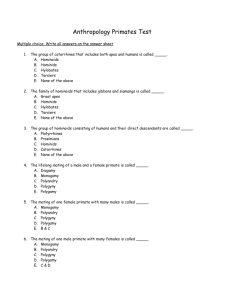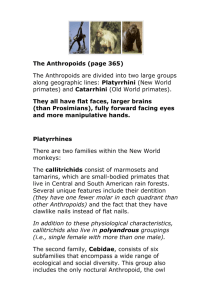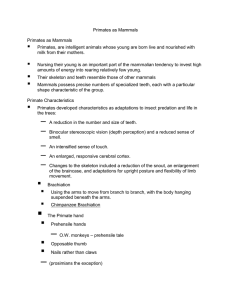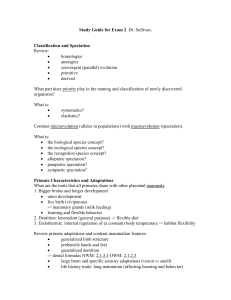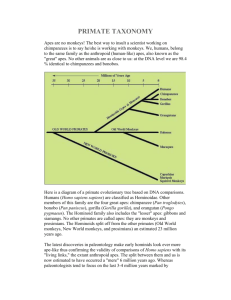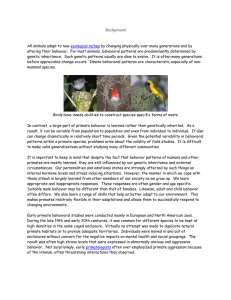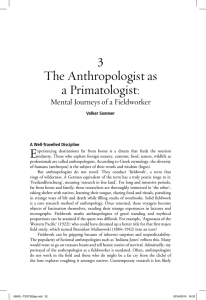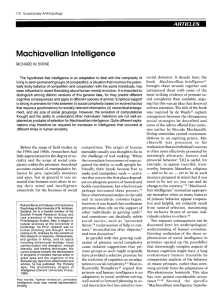Primate Evolution & Characteristics: An Overview
advertisement
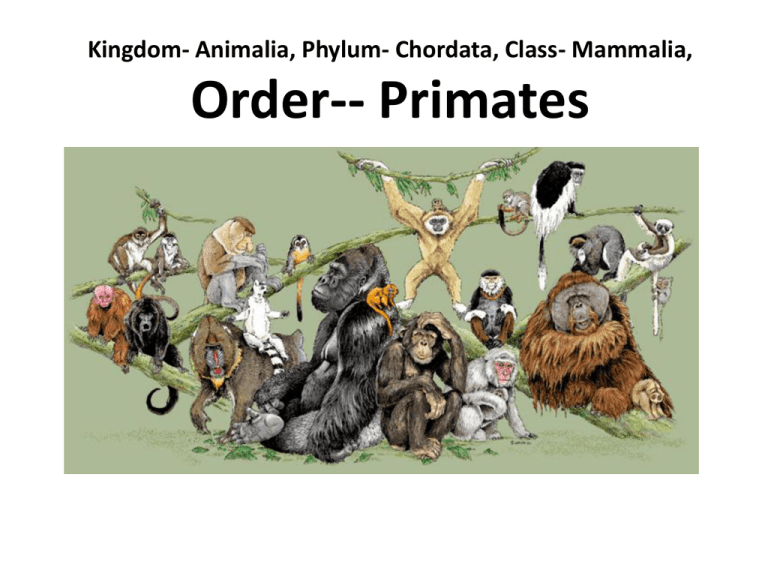
Kingdom- Animalia, Phylum- Chordata, Class- Mammalia, Order-- Primates • appeared around 50-55 million years ago – 10-15 million years after the dinosaurs had become extinct – similar to squirrels in size and appearance – adapted to an arboreal way of life in warm, moist climates – First Primates (13:04) • http://www.pbs.org/wgbh/nova/evolution/firstprimates.html • the order primates includes humans, apes, monkeys, and prosimians • sexually dimorphic--physical differences between the sexes other than the sex organs • 230-270 species – consists of two major suborders: the Prosimii and the Anthropoidea • 48% of primate species are in danger of extinction within the next decade • all of the primates (except spider monkeys) have retained the ancient mammalian trait of pentadactylism (five fingers on hands and feet) – fingers and toes are mobile and have very sensitive tactile pads at the tips – the grasping, or prehensile, ability of primate hands varies as does the degree of opposability of the thumb • has been a progressive reduction in nose size and in the olfactory areas of the brain – of approximately 1,000 human olfactory receptor genes, only 347 remain functional-- the rest have mutations that deactivate them • has been an increase in visual capabilities – all have binocular vision with fields of view that significantly overlap, resulting in true three dimensional (3-D) depth perception or stereoscopic vision Human eyes have an overlapping field of view of about 120 degrees. It is only in this field that we have stereoscopic vision. Beyond this 3-D area out to 160-180 degrees, we see things only in two dimensions (2-D)--i.e., flat without depth. Monkeys and apes have about the same depth perception ability as humans, but the eyes of lemurs are farther apart resulting in a smaller overlapping field of view. • tendency to stand upright • compared to most other animals, primate brains are large relative to their body size – encephalization quotient • a measure of relative brain size defined as the ratio between actual brain mass and predicted brain mass for an animal of a given size • generally have long gestation periods (pregnancies) for animals of their size – offspring are born more mature and therefore, have a greater chance of survival • almost all primates are diurnal • highly social animals • intelligent and opportunistic in getting food • most are unusually adaptable in diet which has tremendous evolutionarily selective value • Behavior – for most animals, behavioral patterns are predominantly determined by genetics – in contrast, a large part of primate behavior is learned • therefore, can change dramatically in relatively short time • Chimps Batter Hives for Honey (2:11) – communicate with smells, sounds, visual messages, and touching – use their environment as it is, without modification (except humans) Suborder– Prosimii • lemurs, lorises, and related animals – the name lemur comes from an ancient Latin word, lemures, which refers to frightening spirits of the dead who haunt people at nighttime – Ring-tailed lemures (:31) – more than half of the lemur species are on the verge of extinction due to habitat destruction 47 million year old Adapidae fossil from Germany (much of the soft tissue, including fur, is fossilized) • major evolutionary changes were beginning in some early prosimians that foreshadow species yet to come – foramen magnum- a hole through which the spinal cord passes – the position of the foramen magnum is a strong indicator of whether the body is habitually horizontal (like a horse) or vertical (like a monkey) • this suggests that they were beginning to hold their bodies erect while hopping and sitting Suborder-- Anthropoidea • at least 145 living species – over 90% of them are monkeys – remaining species are apes and humans • have been the most successful primates in populating the earth • two distinct infraorders of Anthropoidea that have been evolving independent of each other for at least 3 million years – Platyrrhini (New World monkeys) – Catarrhini (Old World monkeys, apes, and humans) Platyrrhini -- New World Monkeys • predominantly arboreal and mostly herbivorous • have nails on all of their fingers and toes • Helping Hands with Capuchin Monkeys (2:19) – http://www.youtube.com/watch?v=iEpJf5-IYwM Catarrhini -- Old World Monkeys • relatively large compared to New World Monkeys – other than Hominids, most familiar are the African baboons. Superfamily- Hominoidae • mostly apes and humans • Did humans evolve from apes (5:33) – • • • • • • http://www.pbs.org/wgbh/evolution/library/11/2/real/e_s_5.html the largest primates all digits have flattened nails short or no tail have large braincase dental formula is the same for all Hominid Family Tree (2:17) – http://www.youtube.com/watch?v=C_o9j00Yp98 Family- Pongidae (the great apes) • differ from other primates in that they lack external tails • more intelligent and more dependent for survival on learned behavior patterns • gibbons, orangutans, gorillas, chimpanzees, and bonobos, and humans) • chimpanzees – more closely resemble humans than do the gorillas – most successful of all apes in that there are more of them and they have the widest geographic range – chimpanzees live in fluid societies of 10-50 individuals. – chimpanzees do not form monogamous mating bonds – http://www.youtube.com/watch?v=WDFh5JdYh7I Madeleine Family- Hominidae (humans) • has been historically difficult for people to accept that we are in fact just another primate species with African origins • habitual bipeds • unlike apes, arms are short and weak compared to our legs • feet have lengthened and acquired an arch (early fossil record contains no foot bones) making them better body supports • longer legs require less up-and-down movement while running and therefore, reduce the amount of energy • have 46 chromosomes in their cells while all of the great apes have 48 • human chromosome #2 is a fusion of ape chromosomes #12 and #13 with most of the same genes – http://anthro.palomar.edu/primate/videos/evol07_ vid_genconnect.html (3:27) • 98.77% of DNA base pairs of humans and chimpanzees are the same – http://www.youtube.com/watch_popup?v=WBEtw7 esmvg&vq=medium#t=14 (1:40) • we differ in the genes that control speech, smelling, hearing, digesting proteins, and susceptibility to certain diseases • volume of modern human brain is 3 times larger than great apes • human brain uses about 25% of the energy derived from the nutrients that we consume and 20% of the oxygen – http://www.youtube.com/watch?v=9JvNwEMXLD8 (7:27) • only primate species that now lacks a thick insulating fur over our entire bodies – allows humans to cool efficiently by the evaporation of sweat • the only species of primate in which all older females go through menopause and become sterile – post-menopausal women around the world often take care of their grandchildren while their daughters are working – argued that this increases the chances that the grandchildren will survive to adulthood • Use with Hominid PowerPoint • http://www.youtube.com/watch?v=awKl8eEv Ktw • http://www.youtube.com/watch?v=zohMSNp W91k&NR=1
